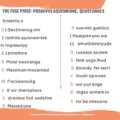The Positive and Negative Affect Schedule (PANAS) is a psychological tool used to measure the two broad dimensions of mood: positive affect (PA) and negative affect (NA). Understanding these affects can provide valuable insights into an individual’s emotional state, which is crucial for mental health and well-being. In this article, we’ll delve into what PANAS is, how it is utilized, and why it is important in both research and clinical settings.
What is the Positive and Negative Affect Schedule?
The PANAS is a self-report questionnaire that consists of two mood scales, one for measuring positive affect and the other for negative affect. Each scale includes a number of descriptive words that respondents rate based on their experiences over a specific period, such as the past week or day. The PA scale assesses emotions such as interest, excitement, and enthusiasm, while the NA scale evaluates distress, upset, and scornfulness.
How is PANAS Used?
PANAS is widely used in psychological research to assess mood states. It can be administered to evaluate the effectiveness of therapeutic interventions, to understand mood swings in clinical populations, or to study the impact of various factors on emotional well-being. In clinical practice, PANAS helps clinicians monitor mood changes in patients over time and tailor treatment plans accordingly.
Benefits of Using PANAS in Research
One of the key advantages of PANAS is its simplicity and versatility. It can be easily integrated into various research settings and is sensitive enough to detect mood changes across different time frames. Moreover, PANAS is a reliable and valid measure, with extensive research supporting its use in diverse populations.
Interpreting PANAS Scores
Interpreting the results of PANAS involves comparing the scores of positive and negative affects. High PA scores indicate high levels of positive emotions, while high NA scores suggest a prevalence of negative emotions. The balance between these scores can reveal important aspects of a person’s psychological state.
Limitations and Considerations
Despite its widespread use, PANAS is not without limitations. Cultural differences, language barriers, and the subjective nature of self-reporting can influence the results. Researchers and clinicians must consider these factors when administering the questionnaire and interpreting its outcomes.
FAQ on the Positive and Negative Affect Schedule
What is the purpose of the Positive and Negative Affect Schedule?
The PANAS is designed to measure the presence of positive and negative emotional states in individuals. It helps in understanding a person’s mood and can be used for psychological research and clinical assessment.
How often can PANAS be administered?
PANAS can be administered as needed, depending on the research or clinical requirements. It can be used for single-time assessments or repeated over intervals to track changes in mood.
Is the PANAS suitable for all age groups?
While PANAS is primarily designed for adults, there are modified versions available for children and adolescents. It is important to use the appropriate version for the target age group.
Can PANAS be used for diagnosing mental health disorders?
No, PANAS is not a diagnostic tool. It is a mood assessment instrument that can provide valuable information to support clinical evaluations but cannot be used to diagnose mental health conditions on its own.
Are there any alternatives to PANAS?
Yes, there are other mood assessment tools available, such as the Beck Depression Inventory and the Mood and Feelings Questionnaire. However, PANAS is unique in its focus on both positive and negative affects.









